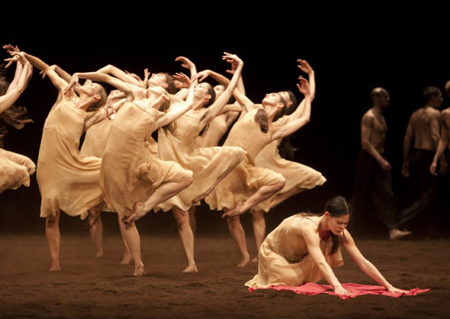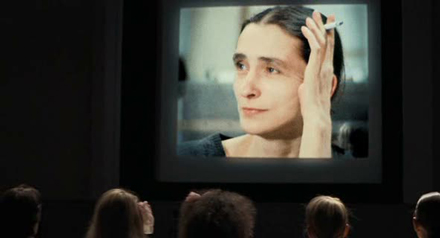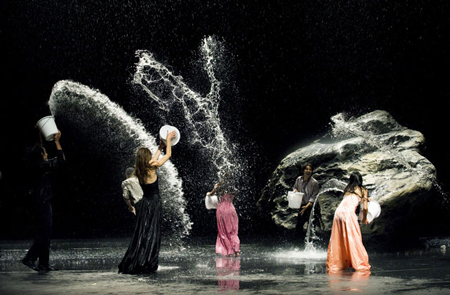
 |
|
|
|
Movies about experimental and modern dance are a tough sell to viewers not already familiar with the art form, but filmmaker Wim Wenders has surmounted the problem in his fascinating film Pina. An intense fan of the Tanztheater Wuppertal Pina Bausch, Wenders was wary of deficiencies in most of the dance movies that he'd seen. Some filmed from a distance so as not to interfere with the dancers' performance, losing the sense of intimacy. Others are too intimate, showing only parts of dancers' bodies and breaking up performances with unwelcome cuts. Pina Bausch also had misgivings about various filmic approaches to dance, and Wenders admits that he felt unable to solve some of the technical-aesthetic problems she posed. He was ready to tackle the show only after seeing a movie about the band U2, which was produced in 3D. The depth effect could give the dancer a dramatic dimensionality, without a need for additional cutting or camera acrobatics. 
Wenders' camera covers a series of dance performances, some of which are played out in the Wuppertal theater and others that use exterior locations. People dance on sidewalks, in fields, in parks and on a sleek aerial monorail train. Wenders' camera matches an on-stage beach setting with wave-swept rocks on a real beach. We see ballet moves that demonstrate the high level of skill shared by these dancers -- but much more of what we see resembles performance art carried off at a much higher level of precision. One dance begins with several barrows of earth spread across the stage floor and raked until it is a smooth carpet. The dancers then leave tracks and impressions in it as they move. Water comes on stage as well. The dancers enter and exit marching-dancing in a line, to an old flat-4 jazz music cue. But most of the musical accompaniment is as abstract as the dancing itself. We see impressive synchronized group work but many more individual dance motions that express various emotions and situations. Bausch's core ideas for motion are often little repeated patterns that are fascinating to look at in themselves -- just the way the bodies move -- yet build to express a larger feeling. One of the more abstract pieces shows a room littered with chairs. A man and a woman embrace, and a second man hurriedly separates them by moving their arms and heads into a different pattern. The "lovers" then crash together again in a tight hug, and the second man repeats the separation process. This must cycle thirty times, faster and faster, until the "dance" becomes a spectacle of thwarted love. Wenders frequently inserts live-action portraits of individual dancers, accompanied by a voiceover of their thoughts about Pina and her methods. They talk about Pina giving them the freedom to find specific moves on their own, urging them on at all times. Asked to express the emotion Joy, one dancer finds this terrific sequence of arm and hand motions that says happiness better than a semaphore signal (his smile helps as well). Pina liked the discovered motion so much that an entire dance was built around it. Twenty people march and wave their arms, communicating the idea, "Joy". 
Some dance bits are alarming, as with a presentation that gives us opposite lines of male and females going nuts with repressed desire for their partners across the hall. The men inch forward thrusting and grasping at the air, while the women writhe and shake themselves in a desperate sex display, like animals that must mate in ten minutes or die. Other bits are light and humorous. A delicate female flexes muscular arms that seem far too beefy to be her own. We understand that a ballerina must possess unusual strength, but this seems all wrong... Pina was in preplanning in 2009 when Ms. Bausch passed away, but the project went forward. As filmed by Wenders, the dances stand by themselves, even as we hear testimony about Pina's indispensability from her colleagues (in a variety of languages). At several points Wenders finds ways of incorporating older, flat footage of Pina into the film. In one dance, we see her "replace" the lead dancer. The moves are practically unchanged between dancers... there's nothing arbitrary or improvised about them. A body of knowledge about dance and its history would surely enrich the experience of seeing Ms. Bausch's troupe. Pina is remarkable in that such a formal education isn't essential -- these dances communicate naturally by themselves. Wim Wenders and his camera people Hélène Louvart and Jörg Widmer support the dancers with stunning imagery, whether in the studio or on location. Some of the exteriors seem untouched but others must have been altered, as when the group walks past a long line of brightly painted posts on the rim of a steep hill. These environments have a touch of the abstract, but are not so weird so as to distract us from the dancers' motions. A few special effects are used, as when the dancers stare into a tiny scale model of the Wuppertal stage, and see little dancers at work within. 
Pina celebrates the talent, personality and dance aesthetics of its subject. The dancers' voiceovers never gush with emotion but simply say why she was special to them. More than one member of the dance company tells us that when they perform, it feels as if she's still there directing them. This Blu-ray of Pina is also The Criterion Collection's first 3D release. It's a beauty, with fine color and a razor sharp image that allows us to appreciate every fkexed muscle and stretch of a leg. It's an all-round visual and technical delight. The 5.1 surround audio track is equally crisp and clear. I saw Pina in 3D in the theater, where it worked beautifully; on Blu-ray the flat HD transfer is almost as good -- wearing the 3D glasses at home seems more distracting. In 3D, single dancers are placed on their own plane of depth, showcasing them spatially was well as compositionally. It's a great format to focus our attention on details of the dance. In the insert booklet we discover that the flat version of Pina isn't simply the left or the right eye of the 3D copy, but a mix of shots from both sides chosen by Wenders. Viewers wanting to learn more about Pina Bausch and Pina will find this disc a delight. It comes with a full Wenders commentary. He's a great raconteur and seems totally invested in this project. A selection of deleted scenes is present, also with audio comments by the director. A separate video interview with Wenders is offered as well, along with a making-of featurette, BTS footage and the trailer. The insert booklet carries an essay by Siri Hustveldt, reprints of pieces written by Wenders and Bausch, portraits of the dancers and an informative, viewer-friendly guide to the dances seen in the film.
On a scale of Excellent, Good, Fair, and Poor,
Pina Blu-ray + 3D rates:
Reviews on the Savant main site have additional credits information and are often updated and annotated with footnotes, reader input and graphics.
Review Staff | About DVD Talk | Newsletter Subscribe | Join DVD Talk Forum |
| ||||||||||||||||||